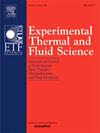基于事件的成像测速技术在湍流中低维坐标的有效估计
IF 2.8
2区 工程技术
Q2 ENGINEERING, MECHANICAL
Experimental Thermal and Fluid Science
Pub Date : 2025-02-05
DOI:10.1016/j.expthermflusci.2025.111425
引用次数: 0
摘要
本研究探索了神经形态事件视觉(EBV)相机在湍流低阶模型坐标数据高效表示方面的潜力。与传统成像系统不同,EBV相机可以异步捕获每个像素的时间对比度变化,提供高频输出,减少数据带宽,提高灵敏度,特别是在低光条件下。脉冲事件成像测速技术(EBIV)与传统粒子成像测速技术(PIV)进行了对比,通过两个同步实验:水下水射流实验和通道方肋周围气流实验。评估包括流量统计数据和光谱含量的详细比较,以及使用适当正交分解(POD)对降阶建模能力的评估。来自EBV相机的事件流被转换成伪快照,从伪快照中使用标准的PIV处理技术计算速度场。然后将这些字段在插值到公共网格后进行比较。模态分析表明,EBIV可以成功识别优势流结构及其能量和动力学,准确识别奇异值、空间模态和时间模态。虽然噪声污染主要影响较高的模式-不太关键的流量控制应用-整体性能仍然稳健。此外,对低阶重建(LOR)的比较验证了EBIV提供可靠的湍流降阶模型的能力,这对流动控制至关重要。这些发现将EBV传感器定位为一种有前途的实时、基于成像的闭环流量控制系统技术。本文章由计算机程序翻译,如有差异,请以英文原文为准。
An assessment of event-based imaging velocimetry for efficient estimation of low-dimensional coordinates in turbulent flows
This study explores the potential of neuromorphic Event-Based Vision (EBV) cameras for data-efficient representation of low-order model coordinates in turbulent flows. Unlike conventional imaging systems, EBV cameras asynchronously capture changes in temporal contrast at each pixel, delivering high-frequency output with reduced data bandwidth and enhanced sensitivity, particularly in low-light conditions. Pulsed Event-Based Imaging Velocimetry (EBIV) is assessed against traditional Particle Image Velocimetry (PIV) through two synchronized experiments: a submerged water jet and airflow around a square rib in a channel. The assessment includes a detailed comparison of flow statistics and spectral content, alongside an evaluation of reduced-order modeling capabilities using Proper Orthogonal Decomposition (POD). The event stream from the EBV camera is converted into pseudo-snapshots, from which velocity fields are computed using standard PIV processing techniques. These fields are then compared after interpolation onto a common grid. Modal analysis demonstrates that EBIV can successfully identify dominant flow structures, along with their energy and dynamics, accurately discerning singular values, spatial modes, and temporal modes. While noise contamination primarily affects higher modes – less critical for flow control applications – overall performance remains robust. Additionally, comparisons of Low-Order Reconstruction (LOR) validate EBIV’s capability to provide reliable reduced-order models of turbulent flows, essential for flow control purposes. These findings position EBV sensors as a promising technology for real-time, imaging-based closed-loop flow control systems.
求助全文
通过发布文献求助,成功后即可免费获取论文全文。
去求助
来源期刊

Experimental Thermal and Fluid Science
工程技术-工程:机械
CiteScore
6.70
自引率
3.10%
发文量
159
审稿时长
34 days
期刊介绍:
Experimental Thermal and Fluid Science provides a forum for research emphasizing experimental work that enhances fundamental understanding of heat transfer, thermodynamics, and fluid mechanics. In addition to the principal areas of research, the journal covers research results in related fields, including combined heat and mass transfer, flows with phase transition, micro- and nano-scale systems, multiphase flow, combustion, radiative transfer, porous media, cryogenics, turbulence, and novel experimental techniques.
 求助内容:
求助内容: 应助结果提醒方式:
应助结果提醒方式:


